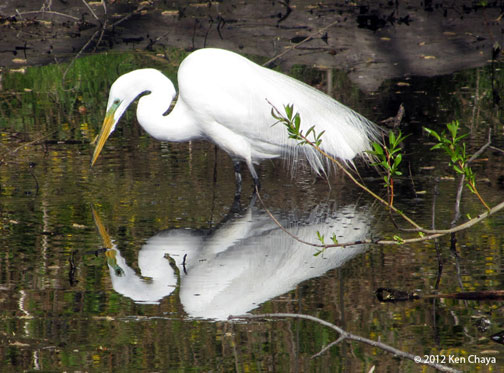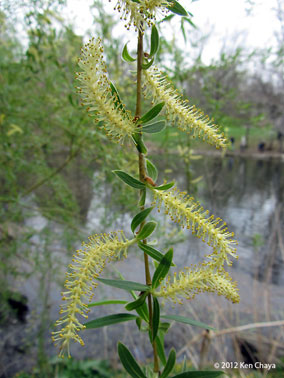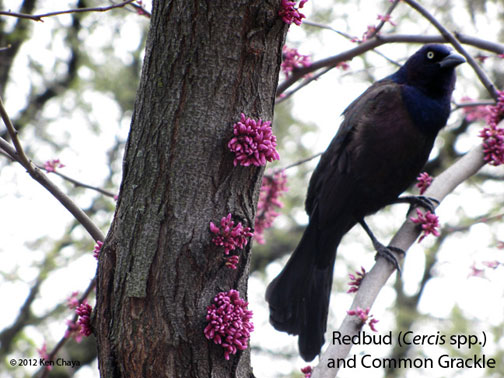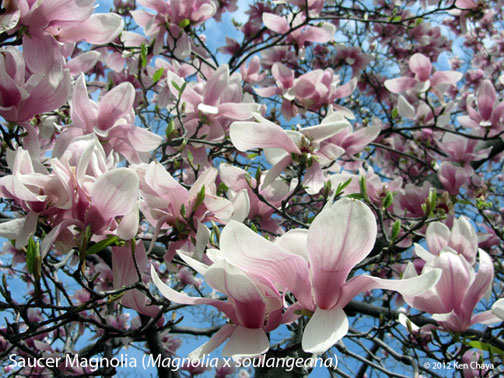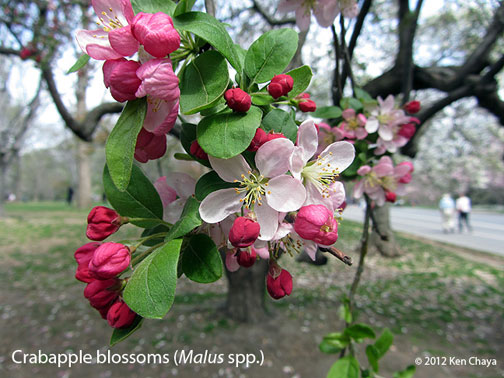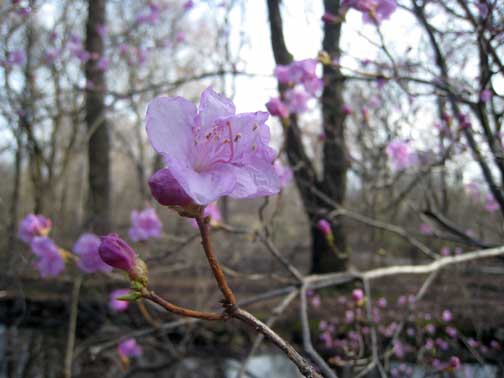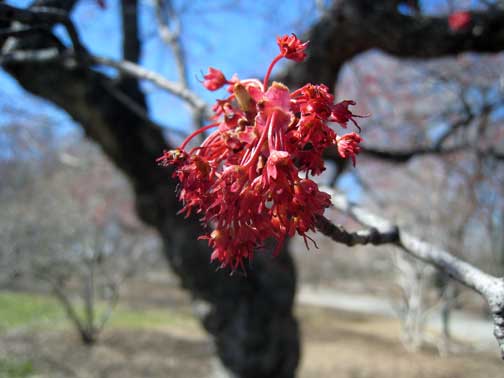
04/01/12 Sunday
Central Park, beginning at the West 103rd Street entrance, and including the Pool, Loch, and Wildflower Meadow.Many thanks to those who were able to attend my last nature walk in Central Park. We got to share some very nice migrant bird sightings as well as observe the emergence of leaves and flowers on several tree species. Here are my notes and a photo or two from that walk.
Birds: A showy and cooperative Great Egret, aka American Egret, (first of season) was strutting it's stuff at the west end of The Pool. The long feathery back plumes extending well beyond the tail show this bird to be in breeding plumage. Another breeding feature is the bill, usually yellow, it now has a deeper orange coloring (see photo). The orange color contrasts beautifully with the bright green lores, the area between the bill and the bird's eyes. It was nice to observe this bird at close range.
Silent, and still as a stone, an American Egret (Casmerodius albus), stalks the west side of the Pool in Central Park.
Canada goose, ubiquitous. Male and female Mallards (as always) were present on the Pool along with a pair of Bufflehead ducks. Buffleheads are diving ducks, so they are quite entertaining to watch. A Red-tailed hawk gave us good looks while perching in tree by Nutter’s Battery. Also at Nutter's we were treated to two Pine Warblers feeding and moving through a bare tree perched over the Harlem Meer. At the A. H. Green Bench, we observed several Golden-crowned kinglets in an Austrian Pine. Other species observed were: Downy Woodpecker, Northern Flicker, Blue Jay, Tufted Titmouse, Brown Creeper, American Robin, European Starling, a single Swamp Sparrow in the Loch, House Sparrows (everywhere), White-throated Sparrows (singing their "Sam Peabody" song), Dark-eyed Juncos, Northern Cardinal, and Common Grackle.
Trees: Once again, we compared the similarities and differences between a London Plane, and it's parent native tree, the American Sycamore. Several crabapples were showing closed flower buds on Sunday. These buds are now open, adding a variety of colors - pinks, whites and even deep reds to the park's magnificent spring palette. The large Bald Cypress at the west end of the Pool and the other three on the south shore are still bereft of needles. This species is a deciduous conifer (one that sheds its needles over the winter). As compensation to the group, they brazenly showed us their woody knees - emerging from the saturated soil along the shoreline. The long branches of Weeping (White) Willows swayed in the wind along the Pool, and we got to observe, close up, the distinct difference between the male flower catkins (see photo) and the female flower growing on separate trees. The willows (genus Salix) are dioecious; that is, the trees are either male or female, as told by their flowers.
The male flowers, or catkins, of this willow resemble tiny bottle brushes and each "bristle" or filament, contains a tiny particle of pollen at its tip.
A mature Black Tupelo on the shore was still lacking leaves while showing it's windswept look of naked branches. A Green Ash nearby was in full bloom showing it's strange clusters of small purple-green flowers. The Red Maples, planted on the far north shore of the Pool are the continuing vision of Frederick Law Olmsted, Central Park's landscape architect who planted this species here over 100 years ago. The gnarled bark of two species: English Hawthorn, and Black Locust, displayed their flakey and furrowed texture for comparison and contrast. On the slope on the south side of the Pool, a large White Oak stood tall and majestic against the blue sky, as the winding and weaving vines of Itea virginica, curled itself around a fence at the shoreline. Pockets of yellow Forsythia announced their presence in the greening landscape around Glen Span Arch. In the Loch we observed both Norway and Sycamore maples. Each are prodigious and are considered an invasive tree species. Their saplings are removed regularly to make room for native trees and shrubs. A Spicebush displayed round, tightly closed flower buds. A slight scrape of a spicebush branch or a crushed leave will produce a sharp aromatic smell. I pointed out the two ancient Red Oak stumps in the Loch. These trees were lost in the mircoburst storm of August 2009. They predated the designing of Central Park. On the east side of the Loch, a Red Maple knocked down in a storm some years ago, had "layered" by using portions of its aerial branches to grow roots and reattach itself into the soil, creating an unusual natural bridge over the stream flowing in from Spring Bank Arch. A very large American Elm and an equally large Red Oak competed for light and space near the water. One of my favorite trees at this time of year, a Pussy Willow, or Goat Willow, put on a show in the Wildflower Meadow. Using a close-up loop, we studied it's colorful, pollen-coated male catkins. Now in full bloom, this tree looks like it is covered with so many tiny, yellow bottle brushes. The huge Red Oak with an enormous spreading crown and the weeping American Beech nearby are also regular favorites of mine in this area of the park. I look forward to seeing them on every visit, and never tire of their engaging and constantly-changing appearance. We saw a good number of Ruby-crowned Kinglets in the Austrian Pines at Green Bench. The young Pitch Pines near Nutter's Battery were identified by the distinctive feature of the tufts of needles and cones which sprout directly from their trunk and limbs. New, tiny male pollen cones were developing on these trees. As we walked out through the North Woods, we noticed a good number of sycamore maple saplings, as well as several young ashes, and admired the group of huge Sweetgums with thousands of their characteristic woody seed balls scattered everywhere on the ground beneath them.
If you have the chance to get out in the park at any time in the next week, do it! The flowering dogwoods are beginning to bloom right now and more new migrant birds are arriving each day.
All best,
Ken
Friends,
Hearty thanks to those who were able to join me on Sunday for our first tree and nature walk of 2012. The weather was damp and chilly. Just right for keeping the crowds down to a comfortable level on a Sunday in Central Park.
Here are my notes and some of the highlights of the day's walk.
3/25/12
Central Park including W 81st Street entrance, Great Lawn area, Turtle Pond, The Obelisk, Hamilton statue area.Birds: A Northern Mockingbird was singing in a pin oak along Central Park West when I arrived at West 81st Street. A Peregrine Falcon flew by over the Great Lawn. Extremely pointed and angled wings and a long flat tail were noted as helpful flight field marks.
Several of the usual suspects were sighted: Blue Jays crying and carrying on. European Starlings, American Robins, House Sparrows and Common Grackles were feeding in the grass together on the Great Lawn. The Blue Jays, House Sparrows, Robins, and Starlings are now year-round residents in the park.
As history tells us, back in 1890, Eugene Schieffelin released 60-100 European starlings in Central Park. Schiefflin was then president of the American Acclimatization Society which wanted to introduce every bird mentioned in the works of Shakespeare to North America. The starlings spread faster than bad news and today they are one of the most problematic, numerous, and wide-spread birds in North America. Pity that Schiefflin and his chums weren't bigger fans of Hawthorne, Cooper, or Twain.
An odd colored female house sparrow with white outer tail feathers and white flashes on her wings was seen feeding in the grass. It flew off before we could have a closer look at it. Some birds possess a form of leucism - a condition characterized in reduced pigmentation that results in a lack of color in some of their feathers. For example, entire feathers that should typically be brown or grey or red are instead white. I believe that this was the case in this individual. A grackle was also observed moving about in an old, low nest in a crabapple tree. Days earlier, I had spotted a male and female House sparrow investigating this same nest site. The grackle was likely in the process of stealing nest materials or perhaps scavenging food debris and refuse from last years' nest.
Trees: Serviceberries (Amelanchier spp.) were in bloom sporting small white flowers. One of the earliest flowering spring shrubs earning it's name by the fact that in the old days after a cold winter it wasn't until late March/early April when the snow finally began to melt and the ground thawed, that funeral services were able to resume.
Redbuds (Cercis spp.) planted around the Diana Ross playground were in various stages of flowering. The deep red and purplish flowers strike a colorful note in the sullen light of a cloudy March day. Also known as the Judas Tree, perhaps due to the seasonal connection to the Easter holiday when it's deep red flowers bloom. Note here that the park seems to be a little ahead of schedule regarding many bloom dates due to the extremely mild winter and recent high temperatures we have had. The early bloomers are very early this year!
The deep red flowers of the Eastern Redbud (Cercis canadensis) will often emerge from the trunks of older trees as well as the branches. They are effective for about 2 or 3 weeks in late March and early April and are admired by park visitors and residents alike.
Several American elms (Ulmus americana) were identified by their vase-shaped habit, snaking limbs, and-present at this time of year-their seedpod (samara) that unlike most other elms, contains a white bearded fringe around its outer edge.
A specimen Red Oak (Quercus rubra), showed off it's near-perfect symmetry and graceful rounded crown in contrast to a nearby free-form Pin Oak (Quercus palustris) which looked as if it had just crawled out of bed.
Atlas Cedars (from the Atlas Mountains of N. Africa) are one of only 4 true cedars, and we observed the bluish pointed needle bundles and small male cones of one close up near the West Drive.
An enormous and stark male ash growing alongside a female ash replete with it's weird blackish flowers emerged theatrically from a cold rocky outcrop of Manhattan schist near the Delacorte theatre. (Did you think that you had to wait until the summer Shakespeare productions to find drama at the Delacorte?)
An American Hornbeam (aka Muscle wood, and Ironwood) displayed it's blue-grey sinewy trunk and limbs. In another seasonal display of spring propagation, the Hornbeams are full of long, dangling male catkins - the pollen-producing male flowers.
One of the big park attractions at the moment are the flowering cherries. Several species are in full bloom with some already beginning to drop their petals as their leaves begin to emerge. Three Weeping Higan Cherries (Prunus subhirtella pendula) were dripping with small white flowers dangling from long flowing branches around the Great Lawn. The Sargent Cherries (Prunus sargentii) showed off their lovely single pink flowers. Other Japanese Flowering Cherries (Prunus serrulata) appeared scattered here and there, easily spotted by their white and pink blossoms. The frothy white cloud of a Yoshino Cherry (Prunus x yedoensis) in full bloom stood out from the pack by it's distinctive dark, gnarled, and ancient-looking bark. These trees can live an unusually long time. There is a beautiful stand of them in full bloom right now along the eastern side of the Reservoir. This year is the 100th anniversary of Japan's gift of these trees to New York and Washington DC. Although many of these trees have been replaced over time, there are a few very large specimens that are possibly from the original planting. Go see them soon while they last!
The lovely twin Silver Lindens shown on the cover of Ned Barnard's terrific book, "New York City Trees" loomed over the far end of the Great Lawn showing their massive rounded crowns against the eastside city skyline. They are now just beginning to show early buds.
A few Red Maples are showing the emergence of soft red leaves from leaf buds. These leaves will soon turn green and by summer many will show bright red stems.
A nice stand of River Birch displayed their rust-colored peeling bark near the east shore of Turtle Pond across from the Statue of the double sword-wielding, King Jagiello. I revealed the sacred secret of the hidden stone turtle at Turtle Pond, a secret much too precious to describe here in detail. (I only reveal this secret to the true believers who have earned the right by accompanying me into the park!)
Leaving the eastern shore of Turtle Pond, we passed by the European Birch (featured in my photographs of winter trees) and noted it's long pointed buds, and 4-sectioned woody fruit capsules.
We headed north toward the Obelisk (aka Cleopatra's Needle). The magnolia species are sensational in this area of the park beginning at the stairway to the Obelisk and running north to the end of the lawn where the statue of Hamilton sits. The trees around the Obelisk are Saucer Magnolias (Magnolia x soulangeana). Note that whenever you see an "x" in a Latin name, it indicates that the species is a hybrid form, a "cross" in other words. Saucer Magnolia flowers begin to open early in the spring, usually during the early part of March. After blooming, if the temperature drops below freezing on a cold night, the tepals will turn brown and quickly drop off. As a result of temperature and weather factors, a Saucer Magnolia can look dramatically different from one day to the next. Enjoy their fragrant blossoms while they last! Two much deeper purple-colored cultivars of soulangeana were seen just north of the Obelisk.
Saucer Magnolias (Magnolia x soulangeana) photographed near the Obelisk, east of the Great Lawn.
Nearby, the lovely Star Magnolias (Magnolia stellata) were in the process of dropping their long strap-like tepals. With between 12-18 tepals typically found on each flower, they could easily afford to lose half of them and still look full and beautiful! There are two pink stellatas in this area near the Hamilton statue and two other white ones. The white form is dominant in Central Park. A beautiful specimen can be seen in the Conservatory Garden.
Star Magnolia (Magnolia stellata) flowers typically open before Saucer Magnolias and like them, the duration of their showy blossoms are at the mercy of the late winter/early spring weather.
A pure white magnolia with large tepals called a Loebner Magnolia (Magnolia x loebneri) can also be found in this area if the park. They are usually the first to bloom and there are several to be found on both sides of the East Drive behind the Metropolitan Museum of Art.
While all of the aforementioned magnolia species are non-natives and come to us from Asia, I also showed two native magnolias, a Sweetbay Magnolia (Magnolia virginiana) and an Umbrella Magnolia (Magnolia tripetala) to the group. It is interesting to note that the native magnolia species typically first produce leaves and then the flowers follow, while with the exotic Asian species, the opposite happens. Great bursts of magnificent flowers come forth before any leaves appear. They bloom dramatic and early. But fear not, our native species will be on the scene soon enough to keep us entertained after the tepals of the Saucer, Lobner and Star magnolias have long since fallen. A question was raised about the large flowering species known as Southern Magnolias (Magnolia grandiflora), and yes, we do have them in Central Park. Two in fact at the southern end of the park. We will have to pay them a visit sometime on another walk.
We also enjoyed the great number of crabapples (Malus spp.) which are just beginning to bloom. The closed flower buds appear scarlet red in color, but open into delicate pink or white flowers. A wonderful transformation.
There are about 30 species of the Malus genus worldwide and over 800 cultivars of these popular fruit trees. Only 4 are considered native to North America. Many of the crabapples in Central Park are cultivars and that often accounts for the wide variety of blossom sizes, shapes, and colors that we admire throughout the spring. The crabapple fruit that ripens in summer and early fall also comes in a variety of colors and sizes. It is an important food source for wildlife (and hungry naturalists.).
Enjoy the spring!
Hope to see you soon in the park,
KenFlowering in March
Ken Chaya found this Korean azalea flowering at the Azalea Pond in the Ramble.
The old red maple near the East Drive behind the Metropolitan Museum of Art...
...was displaying clusters of tiny female flowers, each with a pair of sticky stigmas.
Meanwhile another old red maple at the Wild Flower Meadow was displaying clusters
of tiny male flowers, each with several stamens tipped with pollen-bearing anthers.
Also in the Wild Flower Meadow, a male pussy willow was in bloom.
Yellow pollen-coated anthers were emerging from silky silvery catkins.

The folding map measures 36 x 26 inches unfolded. The southern half of the Park is printed on one side, and the northern half is printed on the other. A full-color Tree Legend appears on both sides. To order the folding version of CENTRAL PARK ENTIRE printed on durable, waterproof synthetic paper, simply click on the “Buy Map” button below.

The poster map measures 59 x 17 inches and comes with a separate full-color Tree Legend for identifying the more than 170 tree species shown on the map. The poster and the Tree Legend are shipped in a sturdy cardboard mailing tube. To order the poster version of CENTRAL PARK ENTIRE, simply click on the “Buy Map” button to the right.
All images and artwork on this site are copyright protected. Copyright © 2011 Edward S. Barnard and Ken Chaya. For information about commercial usage or purchase, please contact us by using the CONTACT button in the main menu.



